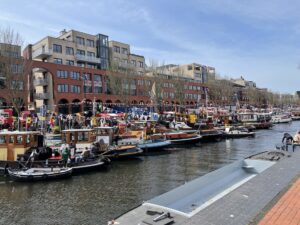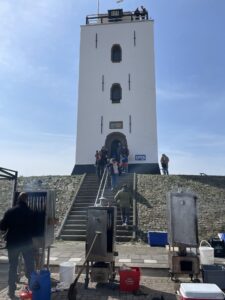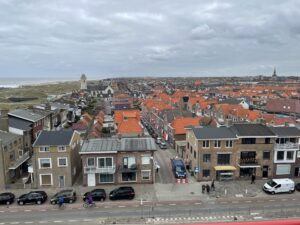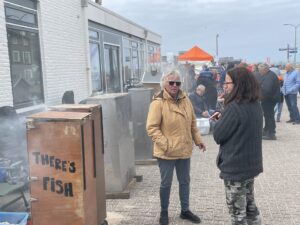Smoked mackerel, shopping centre nightingales, and no-nonsense canteens: Richard Foster takes in twin towns on the South Holland coast.

Dit is een praathuis, en hier zeggen wij wat wij willen.
It may be three o’clock in the afternoon but the speaker, who has us hemmed in a corner of the bar, has downed enough bottles of beer to make his points repeatedly and forcefully. He’s amiable enough, laughing along with our replies in a genuinely friendly manner. A big lad who used to drive articulated lorries, he lives on the estate opposite, a newbuild from the 1950s. Rows of low-roofed houses and three story apartment blocks made of brick — some with wooden front panelling and small gardens and backs — sit huddled together near a row of facilities of the sort that has served this country since the Second World War: a snackbar, a small supermarket and a hairdressers. A grand and reputedly excellent Chinese restaurant is opposite. The only outlet needed to make up the ubiquitous straat of wederopbouw Dutch legend would be a Tabakshop newsagents; but they are rapidly disappearing, as is the kind of pub we find ourselves in.
This old bruin café can be found next to a junction on the 206 A-road which takes you south to Wassenaar, east to Rijnsburg, or north, straight into the twin settlements of Katwijk Binnen and Katwijk aan Zee. It’s a favourite place of ours with its Dutch door and interior of panelled wood, formica tables and potted plants. There is a no-nonsense canteen of meatballs, crisps and bottled mass-produced Dutch lager beer (two varieties). An annex leads on to a large open-plan room reserved for billiards, which is always busy. We often pop in on our way to, or from, the nearby coast.
A pub being designated a praathuis means patrons feel accustomed to say what they want, whether you like it or not. During Covid, lurid banners and flags began to appear in the windows of the estate. These were mainly screen prints of airbrushed artworks, some others handpainted; the gothic or chrome-style lettering of their slogans referring to vaccines and deep states, alongside images of clenched fists, angry blonde families or weeping Dutch lions.
But today the atmosphere is cheery. The estate, like many others in Katwijk Binnen, is decked out in bunting. Innumerable rows of the Dutch tricolour flag flutter on lines running across the streets, like a neverending miniature washing line. Some house doors have huge orange wreaths, resplendent with orange bows. Some wreaths boast a picture of the royal family in their centres. Today is April the 27th, Koningsdag, the Dutch king’s official birthday.
For now, the contentious views from our new lorry driving pal can be brushed aside. We’ve been to the coast, to Katwijk aan Zee, and enjoyed ourselves thoroughly since the early morning. A traditionally strict Dutch Reformed fishing town but a royalist one, the two Katwijks throw off their shackles on Koningsdag and put on a hell of a party. The Dutch monarch’s birthday gives licence for their subjects to claim a kerbside pitch and sell unwanted, or good-as-new goods on the street, tax free. From early in the morning, the press of people is a common sight in many Dutch towns and cities; shuffling past or shifting through old children’s toys or half-understood electrical gadgetry. On this day, there are pitches and stalls everywhere in Katwijk’s centre. One long row, placed alongside the Prins Hendrikkanaal which leads to the town’s old harbour, sells socks, bags, watches, toiletries and other household items; a handy spot for such trade, given the harbour is now repurposed as a residential and leisure complex. A small craft market in an independent cultural centre up by the lighthouse is also worth pottering around. It offers an assortment of handmade postcards, t-shirts with strange designs (mushroom headed ninjas wielding swords, for instance) and the ubiquitous hand painted-effect decorative wooden plaques, with their cheery English slogans.

Alongside these staples, Katwijk’s other entertainments may reflect something more indigenous. There are sea shanties and singalongs with a number of local choirs dotted around the town. A pop-up community centre near the Prins Hendrikkanaal shows mannequins wearing examples of the striking traditional local dress that hung on until the Second World War. At the entrance, a number of middle aged ladies preside over demonstrations for rope tying and mending and patching fishing nets. Some of the nearby stalls sell local produce, from the benign (local honey, freshly smoked eels, handmade paper products) to the questionable (full scale rifles and swords, carved out of wood). A display of vintage barges is moored in a line fore and aft along the canalside, reminding us all that this country’s commercial and social arteries were, until very recently, water-driven. Parked adjacent are lines of restored fire engines, tractors and lorries. More fun from the industrial age can be found with a wonderful display on a walkway over the water, which hosts working vintage pumping engines. A devoted knot of men and boys stand and film the greasy, shuddering contraptions, oblivious to the streams of people passing by.
You can also visit the lighthouse near the promenade facing the dunes and flick through the stands of curling postcards from the 1960s. Framed photographs on the wall show the old seafront with fishermen and their families driving horse-drawn carts over the beach gathering cockles, or hawling flat bottomed klinker boats out of the water. The lighthouse gantry affords a sweeping view over the low lying houses that nestle in the lee of the dunes, the architecture a mix of 1950s and 1970s developments and those structures fortunate enough to survive the complete clearance of the seafront by the Wehrmacht during the occupation. From here you can’t miss the white church — often painted in the nineteenth-century when Katwijk was a popular spot for artists. It is still the focus of the original village centre, and on Koningsdag oversees youth theatre and cheerleader displays. Each year, at the lighthouse’s base, a very enjoyable scene develops around a line of portable mackerel smokeries. Fags in mouths and a flask of something to hand, the owners sit contentedly on folding stools, slowly smoking the rows of fish hung in their portable wood and metal contraptions. This is a pastime for the dedicated; one smokery even has a built-in sound system.

There is much more to be said for the village outside of this particular day of celebration; eating the local fried fish is worth travelling in for alone. And for the socially and environmentally conscious, the dunes at the seafront hide a huge underground car park; a classic example of the practical attitude the Dutch have to solving everyday problems whilst taking heed of environmental strictures. There are two well-supported local football teams, (VV Katwijk and Quick Boys), a number of museums including one for local archaeology and wildlife, and a well-established and informative museum of the town and district. There is also an underground music scene flourishing at the youth centre JVC De Schuit, which has one of the most progressive music programmes in Holland. The historically minded can visit accessible portions of the Atlantikwal, including, in the nature and recreation area Pan van Persijn, one of the best preserved concrete tank walls left standing. And cycling the new routes through the surrounding dunes, with their hidden knolls and secret pools, clumps of oak, rosehip and thorn bushes, one can’t help but come into contact with the large populations of bird and insect life. Nightingales can be heard in the dunes backing on to one shopping centre complex in Katwijk Binnen.

Experiencing all of this in full swing, especially in summer when the area welcomes many German and Dutch tourists, would lead you to believe that the area and community is thriving, sure of itself and able to process the increasing pressures of modern life. And yet, like many coastal communities, Katwijk is being reformed by the slow, tectonic shifts brought about by social, demographic and environmental change. This is also a locality where the fallout from partying hard has played an increasing part over recent years. Dealing just with God, the produce of the sea and land is not enough, it seems; especially in the “permagrey” winters. The town is increasingly positioned as one where commuters to Leiden and Den Haag settle; less posh, or “international” than nearby Wassenaar, but less touristy than Noordwijk. Consequently, new building and resettlement schemes now surround Katwijk Binnen and Katwijk aan Zee like the encampments of besieging armies. Things get cleaned up in consequence; the old “inbetween” farms and wastelands, with their paddocks and gloomy old sheds, and the nearby decommissioned and overgrown military bases are increasingly a thing of memory. One wonders whether the beautiful new cycle paths and information centres will be enough of a fillip over time.
*
Richard Foster is an artist and writer. He runs the Museum of Photocopies.